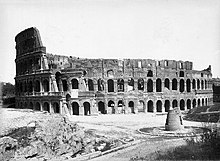Sergio Panunzio was an Italian theoretician of national syndicalism. In the 1920s, he became a major theoretician of Italian Fascism.

Andrea Carandini is an Italian professor of archaeology specialising in ancient Rome. Among his many excavations is the villa of Settefinestre.

Pietro Rosa was an Italian architect and topographer. He studied the settlements of the ancient Roman countryside and carried out a systematic series of excavations on the Palatine Hill in Rome.
Clementina Panella is an Italian archaeologist, a professor at the University of Rome La Sapienza, where she teaches Methodology of Archaeology. She has guided and co-written a number of articles on the commercial pottery of ancient Italy.

The Museo Nazionale della Magna Grecia, Museo Archeologico Nazionale di Reggio Calabria or Palazzo Piacentini is a museum in Reggio Calabria, southern Italy, housing an archaeological collection from sites in Magna Graecia.
Ficana was an ancient city of Latium, which figures in Roman history only on the occasion of its conquest by Ancus Marcius, who is said to have moved the inhabitants to Rome, and destroyed the city itself. It is certain that it was never repeopled: its name is found in Pliny's list of the extinct cities of Latium, and is noticed also by Festus as a place no longer in existence. The latter passage, however, affords us a clue to its position; according to Marcus Antistius Labeo there cited, it was situated on the Via Ostiensis, eleven miles from Rome, and apparently immediately adjoining the Tiber, on which it had a port, at a place called by Fabius Pictor the Puilia Saxa. The city's site is in the commune of Rome near Acilia, on the via Ostiense between Rome and Ostia.
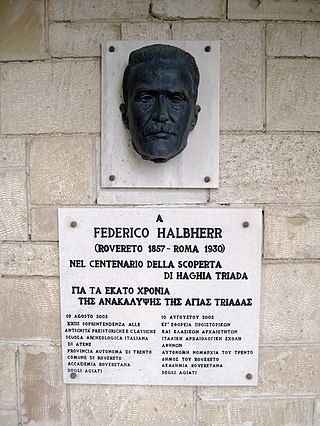
Federico Halbherr was an Italian archaeologist and epigrapher, known for his excavations on Crete. In particular, he is known for his excavations of the Minoan palace at Phaistos and the Minoan town of Hagia Triada. A contemporary, friend, and advisor of Arthur Evans, he began excavating at Phaistos before Evans began excavating at Knossos. Some of his work was funded by the Archaeological Institute of America.
Margherita Guarducci, also spelled Guarduci, was an Italian archaeologist, classical scholar, and epigrapher. She was a major figure in several crucial moments of the 20th-century academic community. A student of Federico Halbherr, she edited his works after his death. She was the first woman to lead archaeological excavations at the Vatican, succeeding Ludwig Kaas, and completed the excavations on Saint Peter's tomb, identifying finds as relics of Saint Peter. She has also engaged in discussions on the authenticity of the Praeneste fibula, arguing that its inscription is a forgery.
Thesaurus Florentinus is a project for the acquisition and reconstruction of the images of the mural paintings in the Cupola of Santa Maria del Fiore in Florence and a computer system to manage the hundreds of thousand pieces of information gathered during the restoration campaign ended in 1995. The project was conceived by Arch. Riccardo Dalla Negra and realised by Lapo Bertini, Silvia Brotini, Auro Pampaloni, Marco Menichetti, Lara Calosi and Arianna Sacchetti with the technological support of IBM and Eastman Kodak and the financial support of the Ministero dei Beni Culturali of Italy and Ente Cassa di Risparmio di Firenze. The project started in 1992 and ended in 2000.
Clelia Giacobini was an Italian microbiologist, and also a pioneer of microbiology applied to conservation-restoration.
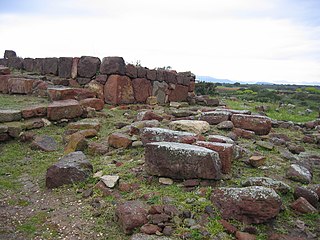
Monte Sirai is an archaeological site near Carbonia, in the province of South Sardinia, Sardinia, Italy. It is a settlement built at the top of a hill by the Phoenicians of Sulci. The history of studies in Monte Sirai has a very precise date: the fall of 1962, when a local boy casually found a female figure carved on a stele of the tophet. Following further inspections, in August 1963, the local Soprintendenza and the Institute of Near Eastern Studies of the Sapienza University of Rome started excavations, leading to a fairly comprehensive study of the entire town.
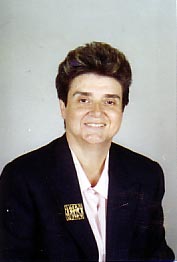
Anna Maria Bisi, known as A. M. Bisi, was an Italian archaeologist and academic, specialising in the Phoenicians and Punics.

Lucia Travaini is an Italian numismatist, archaeologist, and academic. She is an Associate Professor of Medieval and Modern Numismatics at the University of Milan.

Maria Floriani Squarciapino (1917-2003) was an Italian classical archaeologist and professor at La Sapienza University in Rome, known for her work on the Roman port city of Ostia.

The zones of Rome are toponymic subdivisions within the area of the Ager Romanus, belonging to the Municipalities of Rome and Fiumicino, Italy.
Orlando Paladino Orlandini was an Italian sculptor, born in Scansano (Grosseto). He trained in Carrara to gain experience of working with marble before going on to study in Rome at the Accademia di Belle Arti, the School of Medals and the Calcografia Nazionale. He later taught at the Scuole del Museo Artistico Industriale.
Maria Giulia Amadasi Guzzo is a leading scholar in Semitic epigraphy. She is Professor of Semitic Epigraphy at the Department of Sciences of Antiquity of the Sapienza University of Rome, and the director of the "Museum of the Near East" of the University La Sapienza. She is a corresponding member of the German Archaeological Institute.

Sacri Cuori di Gesù e Maria a Tor Fiorenza is a 20th parochial church and titular church in Rome, dedicated to the Sacred Heart of Jesus and Immaculate Heart of Mary.
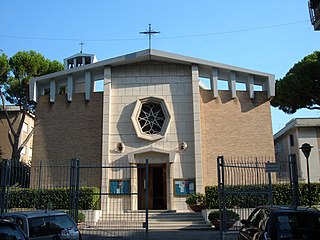
Santa Maria Immacolata di Lourdes a Boccea is a 20th-century parochial church and titular church in Rome, dedicated to Our Lady of Lourdes.
San Pier Damiani ai Monti di San Paolo is a 20th-century parochial church and titular church in the southwest suburbs of Rome, dedicated to the 11th-century saint Peter Damian.



